The first counselling session with a child is a crucial opportunity to establish trust and create a safe space for open communication. It lays the foundation for building a therapeutic relationship, allowing the child to express feelings and concerns freely. This initial interaction sets the tone for future sessions, making it essential to approach it with sensitivity and understanding. Techniques like play therapy and active listening are often used to engage the child and facilitate emotional expression, ensuring a positive experience from the start.
Overview of the First Session
The first counselling session with a child is a foundational step in establishing trust and understanding. It involves introducing the counselling process, setting boundaries, and creating a comfortable environment. Icebreakers and play-based activities are often used to engage the child and help them express their feelings. The session also focuses on identifying the child’s concerns and expectations while ensuring confidentiality. This initial interaction sets the stage for future sessions and builds a positive therapeutic relationship with the child.
Building Rapport and Trust
Building rapport and trust is essential in the first counselling session with a child. Active listening, empathy, and a non-judgmental attitude help the child feel safe and understood. Engaging in play or creative activities can foster connection and reduce anxiety. Consistency and clear communication are key to establishing trust, allowing the child to feel comfortable expressing their emotions and concerns. This foundation is vital for a positive therapeutic relationship and effective counselling outcomes.
Creating a Safe and Comfortable Environment
Creating a safe and comfortable environment is vital for a child’s first counselling session. Ensure the space is quiet, welcoming, and free from distractions. Use age-appropriate toys, art supplies, or play materials to help the child feel at ease. Establishing privacy and explaining confidentiality can build security. A calm and empathetic tone, along with a non-threatening atmosphere, encourages the child to express themselves openly. This setup fosters a sense of safety and readiness for the session.
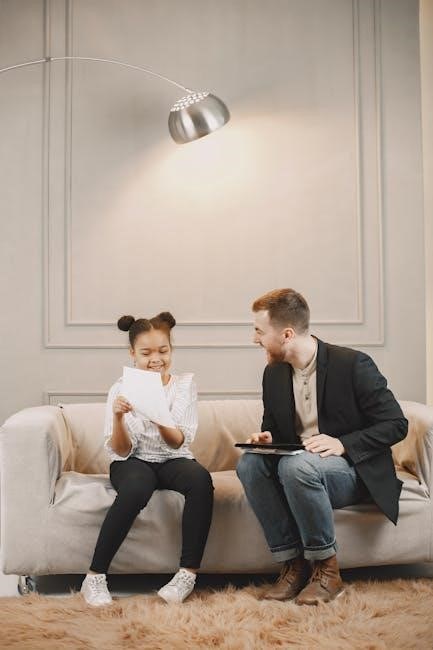
Preparation for the First Counselling Session
Preparation involves understanding the child’s needs, gathering background information, and organizing a welcoming space. It ensures the counsellor is ready to create a supportive and structured environment.
Understanding the Child’s Needs and Background
Understanding the child’s needs and background is vital for effective counselling. Gather information from parents or guardians about the child’s emotional, social, and academic history. Review any previous records or assessments to identify potential challenges or developmental delays. Be aware of cultural or family dynamics that may influence the child’s behavior. This insight helps tailor the counselling approach to the child’s unique circumstances, ensuring a more personalized and impactful session. It also aids in addressing specific concerns early on.
Preparing the Physical Space for the Session
Creating a comfortable and inviting environment is essential for a child’s first counselling session. Ensure the space is child-friendly, with age-appropriate toys and materials. Arrange seating to promote interaction while respecting personal boundaries. Soft lighting and minimal distractions help the child feel secure. A clean, organized space conveys professionalism and care, fostering trust from the outset. The physical setup should encourage exploration and comfort, making the child feel at ease during the session.
Explaining the Counselling Process to the Child
Explaining the counselling process to a child involves using simple, age-appropriate language to describe what will happen. Emphasize that the session is a safe space to talk about feelings and experiences. Highlight the use of play, art, or other activities to express emotions. Reassure the child that confidentiality is respected, while also explaining when it’s necessary to involve parents or guardians. This clarity helps the child feel prepared and comfortable, fostering trust and openness from the beginning.
Structure of the First Counselling Session
The first session typically includes icebreakers, identifying the child’s feelings, and setting clear boundaries. It balances engagement with establishing a structured yet flexible framework for future sessions.
Starting the Session: Icebreakers and Engagement
Starting the session with engaging icebreakers helps the child feel comfortable and builds rapport. Activities like drawing, storytelling, or simple games encourage participation and reduce anxiety. These exercises allow the counsellor to observe the child’s communication style and emotional state. The goal is to create a relaxed atmosphere, fostering trust and making the child receptive to the counselling process. This initial engagement sets a positive tone for open expression and collaboration.
Identifying the Child’s Feelings and Concerns
Identifying the child’s feelings and concerns is a critical step in the first session. Techniques like active listening and open-ended questions help the child express emotions. Play therapy and art activities provide non-verbal ways for children to communicate their concerns. Creating a trusting environment encourages honesty, allowing the counsellor to understand the child’s emotional state and address underlying issues effectively. This process lays the groundwork for further exploration and support in subsequent sessions.
Setting Boundaries and Expectations
Setting boundaries and expectations is essential in the first session to create a structured and respectful environment. This process begins with explaining confidentiality and session rules, ensuring the child understands the limits. The child’s participation in setting these boundaries fosters a sense of control and responsibility. Using simple language and examples, such as in play therapy, helps clarify expectations. This collaborative approach ensures the child feels safe and engaged, laying a foundation for a trusting therapeutic relationship.
Techniques for Engaging the Child
Engaging a child involves creative and interactive methods like art, games, and play therapy. These tools help build trust and encourage the child to express emotions effectively.
Play Therapy and Its Benefits
Play therapy is a powerful tool in child counselling, allowing children to express emotions and experiences through natural play. It helps reduce behavioral and emotional challenges, fostering a safe space for exploration and healing. This approach is particularly effective in the first session, as it builds rapport and trust, enabling the child to communicate comfortably without the pressure of verbal interaction.
Using Art and Creative Activities
Art and creative activities provide an engaging way for children to express their thoughts and feelings during the first counselling session. Techniques like drawing or painting allow children to communicate non-verbally, helping them explore emotions they may struggle to articulate. These activities also foster a sense of control and creativity, making the session more enjoyable and less intimidating, while providing insights into the child’s inner world and concerns.
Active Listening and Empathy
Active listening and empathy are essential in the first counselling session with a child. By attentively listening to the child’s words, tone, and body language, the counsellor builds trust and understanding. Empathy helps the child feel validated and heard, fostering a safe environment for open communication. These techniques encourage the child to express their feelings freely, laying a strong foundation for the therapeutic relationship and future sessions.
Involving Parents or Guardians
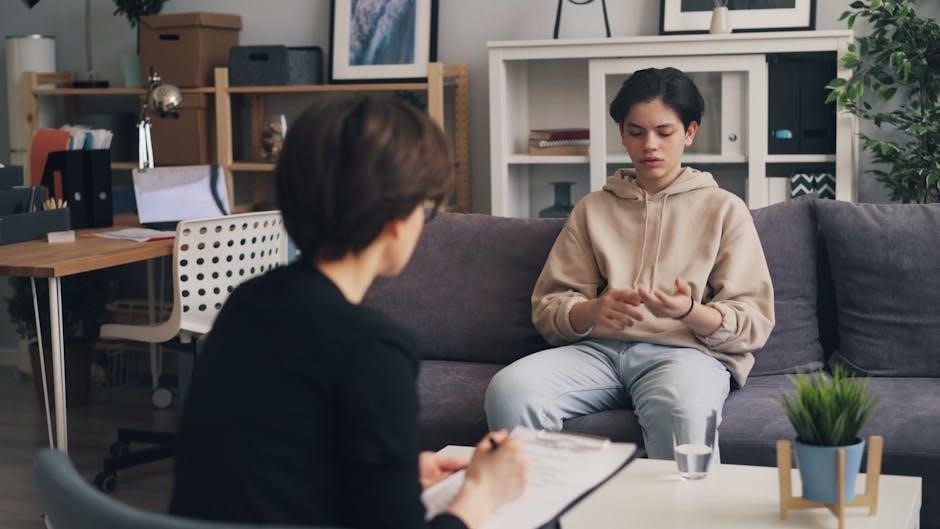
Active listening and empathy are vital in engaging a child during the first session. By attentively listening to their words, tone, and body language, the counsellor builds trust and understanding. Empathy helps the child feel validated, fostering a safe space for expression. Reflecting back the child’s statements and maintaining a non-judgmental stance encourages openness. This approach allows the child to process emotions and feel supported, creating a strong foundation for the therapeutic relationship.
Communicating with Parents Before the Session
Effective communication with parents before the first session is essential to ensure alignment and understanding. Inform them about the session’s purpose, confidentiality boundaries, and their role in supporting the child. Discuss the child’s specific needs and any background information relevant to the counselling process. This collaboration helps build trust and creates a unified approach to supporting the child’s emotional well-being. Clear communication fosters a positive environment for the child’s growth and therapeutic progress.
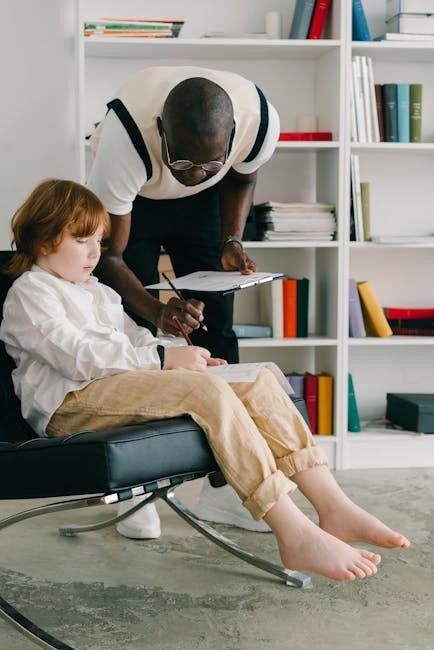
Setting Expectations for Parental Involvement
Clearly defining parental involvement expectations is vital for a collaborative approach. Parents should understand their role in supporting the child’s therapy while respecting confidentiality. They can assist by providing background information and maintaining open communication with the therapist. Setting boundaries ensures the child’s autonomy while fostering a supportive environment. This balanced approach helps parents feel involved without overstepping therapeutic boundaries, promoting the child’s emotional growth and positive outcomes from the counselling process.
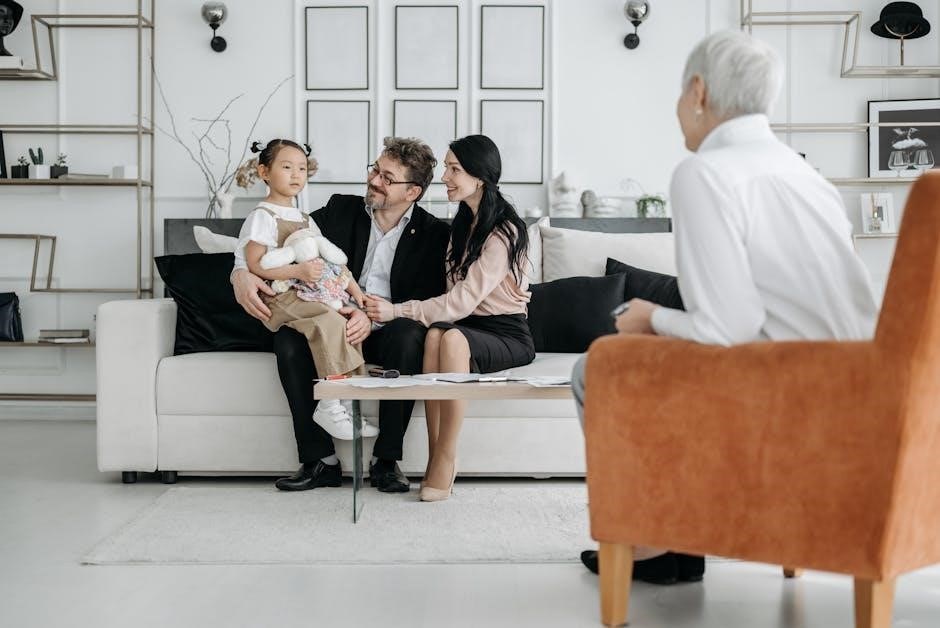
Maintaining Confidentiality and Boundaries
Maintaining confidentiality and boundaries is essential in child counselling to build trust and ensure a safe environment. The child must understand that their disclosures are private, except in cases of safety concerns. Therapists should clearly communicate these boundaries while involving parents appropriately. Confidentiality fosters openness and strengthens the therapeutic relationship, allowing the child to feel secure in expressing their feelings and concerns without fear of judgment or repercussions.
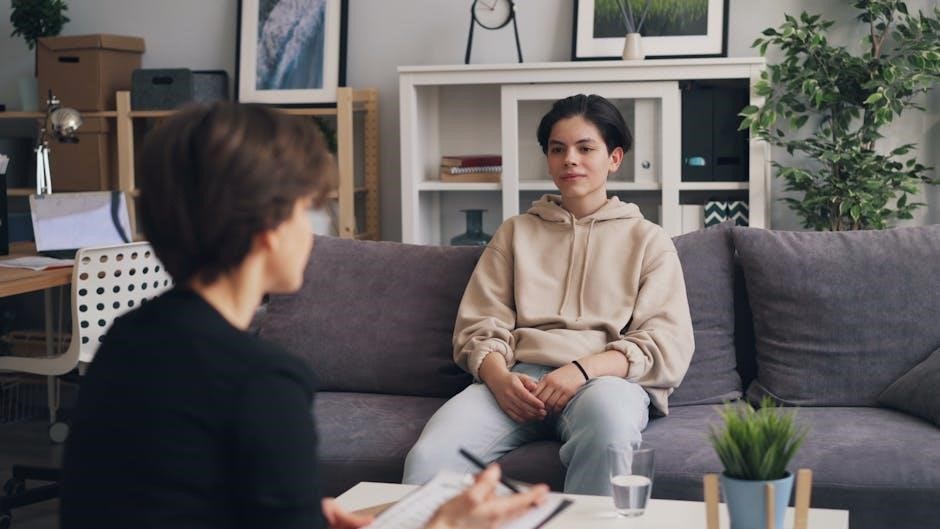
Documenting the First Session
Documenting the first session involves recording key observations, such as the child’s behavior, emotional expressions, and main concerns discussed. This helps track progress and inform future sessions.
What to Include in Session Notes
Session notes should include key observations about the child’s behavior, emotional state, and main topics discussed. Note the child’s responses to activities and any significant disclosures. Document the child’s engagement level and overall demeanor. Record any agreements or plans made for future sessions. Also, include any feedback or insights gained during the session. Maintain confidentiality while ensuring the notes are clear, concise, and focused on the child’s progress and needs.
Assessing the Child’s Response to the Session
Assessing the child’s response involves observing their behavior, emotional expressions, and engagement during the session. Note their reactions to activities and discussions, as well as any signs of comfort or resistance. Pay attention to verbal and non-verbal cues, such as body language and tone of voice. Evaluate their ability to express feelings and participate in the process. This assessment helps gauge the child’s readiness for further therapy and informs adjustments to future sessions.
Planning for Future Sessions
Planning future sessions involves setting clear, achievable goals based on the child’s needs and progress. Identify specific areas to focus on, such as emotional regulation or social skills, and outline activities that align with these objectives. Consider the child’s preferences and strengths to ensure engagement. Develop a structured yet flexible approach, allowing for adjustments as needed. Collaborate with parents to maintain consistency and support the child’s growth between sessions.

Key Takeaways and Next Steps

Building rapport and trust is essential in the first session. Use engaging techniques like play therapy to foster connection. Set clear goals and provide constructive feedback to guide future sessions effectively.
Reflecting on the Session’s Outcomes
Reflecting on the session’s outcomes helps assess the child’s comfort level and engagement. Evaluating their responses and body language provides insights into their emotional state. Noting progress, such as increased openness or trust, is crucial. Identifying areas needing more attention ensures future sessions are tailored to their needs. This reflection also helps in refining therapeutic strategies to better support the child’s development and well-being.
Providing Feedback to the Child and Parents
Providing feedback to the child and parents is essential for fostering collaboration and understanding. Share observations about the child’s engagement and progress, ensuring feedback is constructive and age-appropriate. Highlight strengths and areas for growth, while maintaining confidentiality. Inform parents about their child’s responses and involve them in setting future goals. This open communication helps build trust and ensures a united approach to supporting the child’s development and well-being.
Setting Goals for Subsequent Sessions
Setting clear, achievable goals for future sessions is vital for guiding the counselling process. Collaborate with the child and parents to establish specific objectives tailored to the child’s needs. These goals should be realistic and aligned with the child’s development. Techniques like play therapy or art activities can help achieve these goals. Regularly reviewing and adjusting objectives ensures progress and maintains focus on the child’s emotional and psychological growth.
